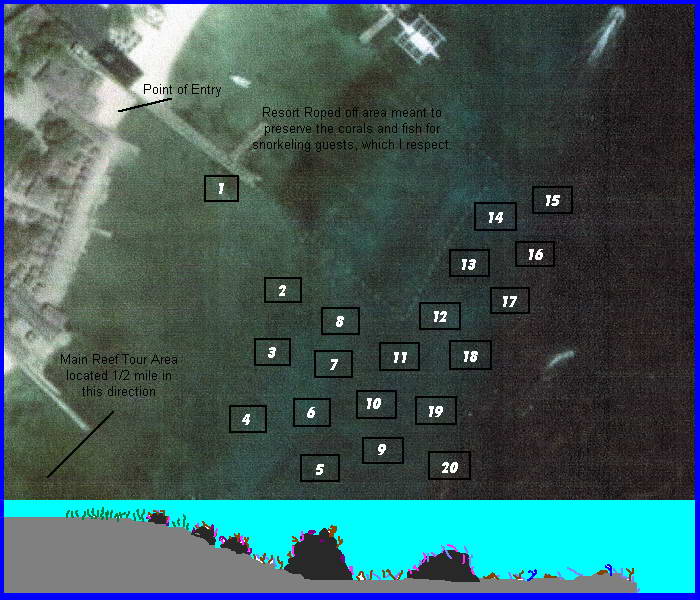
0 - 5 feet deep
5 - 20 feet deep
15 - 30 feet deep
200+
This area of the island is where
the deep vertical wall gets much closer to shore and is where I do all
of my scuba diving because of that. As you can see in the above photo,
the grassbed areas are much smaller than Marigondon's area, this
is due to the fact that the landscape slopes down from shore much
quicker. There is also not much sargassum kelp to speak of due to the
greater depths.
Changes made to the above: 05 June 07
- Added new area, look for the photos to change though as I get better
ones, those shown were all taken today and are not the best of the
best. 18 July 07 - Added a 2mb Movie of the reef crest located near area 18 (link above). 26 July 07 - Updated Areas 16 and 19. 22 August 07 - Updated Areas 12 and 5. 08 Nov. 07 - Updated Area 2.
11 Dec. 07 - Updated Areas 9 & 3. 04 Feb.08 - Updated Areas 6 & 11.
Basic ocean parameters (as found on this reef) and personal observations :
Test Results taken on 30 Aug. 2007 at 2pm, High Tide
Temp. = 84F Salinity = 32 Calcium = 420 KH = 9 pH= 8.4 Phosphates = 0 Nitrates = 0
Having taken weekly temperature, salinity and pH tests since
2004, as well as
observing seasonal changes, storms, tidal movement and other factors
that effect the reef on a daily and long term basis, I have a fairly
good idea as to what the local habitats and the animals that live
within them are adapted to.
The following notes include some hard data as well as some
observations. Since this presentation is geared towards the reef
keeping hobbyist, I hope that it will be of
use in our own aquarium methodology. After all, the animals we keep
aspets come from just such environmental conditions.
If I were to make one point (which I am), it would be that we,
as hobbyists, need to get the word "stable" out of our vocabulary. This
reef is far from being any where near the description of stable. It
does however have its daily and seasonal ranges, yet never static.
Every thing is in a constant state of change or motion, how ever
drastic or slight those changes may be, be it sand and rocks disturbed
by tidal and storm activity, a particularly heavy rainfall, a lengthy
period of cloud cover, the growth and decline of both corals and algae,
down to all of the daily feeding activity makes for a very dynamic and
ever changing system. All done within set tolerances.
Temperature : Actually quite variable, but only
variable within a set range. Which for this reef can be a low of 80 to
a high of 90. The factors that determine any given
temperature involves :
Seasonal Fluctuations, Which for the tropics involves only two.
A wet cloudy, thus cooler season, and a dry cloudless, much warmer
season. On a seasonal average, I would say that during the wet season,
the daily average is 80 F. While during the dry season, the daily
average is 84 F. With an overall yearly average right at 82 F. Water
depth and proximity to deeper water currents also greatly effect the
day to day temperature swings.
In the shallow grass beds, during a lull in the tides and on a
sunny day, the temperature can easily reach 90 F. On that same day, the
deeper, coral reef can reach 84 F. Yet when a low tide flushes the much
warmer water out into the deeper reefs, the temperature climbs quickly
to 86 F. The reverse happens when a high tide brings in cooler water
from the much deeper open ocean. Going from 84 F. to 80 F. in a matter
of hours. Night time temperature drops usually deducts about 4 degrees
from the daytime average.
Salinity : Maintained at a yearly average of 1.023
dropping to 1.022 during periods of heavy rainfall. Since the Camotes
Sea is formed by a series of large islands, heavy rainfall will wash in
a great deal of fresh water and for a few days, will lower the overall
salinity until the tides bring in open ocean water.
pH : This parameter does not seem to have a great
deal of fluctuation with a daily 2pm average of 8.4 while dropping off
to about 8.3 at night. I expected to see a greater swing and can only
assume that with the vast amount of ocean water, such changes occur
much slower due to a much greater buffering capacity.
Tidal Movement : The only real source of water
movement since the surrounding large islands block any wind formed
waves as well as any oceanic currents. That is not to say that this
area is calm. Far from it.
During some of the larger tidal differences (between highs and
lows), there have been many a time when I have regretted going too far
out over the reef and have had to fight my way back in against a tide.
On average though, tidal movement allows me to just drift along slowly
and enjoy the view. This does not mean however, that there is a "slow"
flow. The sheer volume of water passing by in a linear fashion is more
power than we can usually imagine. Of course the landscape plays a
large role as well. Any obstacles such as coral heads or rock
outcroppings will break up the linear flow and form upwellings and calm
pockets behind any such obstacles.
Such flow can be observed by watching how the larger algae and
less rigid corals are moved or not moved about. This particular reef
area is a bit unique in that it has a large shallow (sea grass) shelf
that extends quite far out. A half mile in up the shoreline, and the
drop off or wall comes almost right up to the shoreline. This reef's
extended shallow area also provides for a different flow during the
tidal changes simply because you have alot of water coming directly out
from shore hitting the stronger and deeper flow broadside. Which adds
quite a bit of turbulence in the areas where they meet.
This area of higher turbulence also happens to be exactly where
the corals are at their highest density. Whether this is by chance or
by design, I am not too sure of. To view greater details of this areas
tides, please click HERE.
Water Clarity / Turbidity : Another highly variable
parameter. From day to day, week to week, it is never the same. On some
days, underwater visibility can be but a
few feet, other days, it can be as good as fifty feet.
Having dived on a great many reefs throughout the world, I would
have to say that this one is much more turbid (silty?) than most other
reefs. As for a reason to the greater turbidity, I would have to guess
that it is again due to being a narrow sea containing a shoreline on
both sides of the sea, (see above map) providing for much greater shore
based run off as well.
Acting much like a large river during tidal movements. The
average "cloudiness" of the water may explain why most of the corals
are found living or restricted to a shallower depth than those found in
much clearer waters. When I say most, I speak of those species that are
most dependent upon sunlight for their needs. There are of course a
good many species that I do find living in what I would call "dark"
water.
When it comes to what we, as hobbyists are usually told as to
the lighting requirements of corals, I have found / observed that
corals are a great deal more adaptable than we give them credit for. I
have seen a coral species growing in two feet of water, sitting out in
the full sun all day long, and being subjected to high temperatures for
short periods and can then go out to the deeper reefs, and find that
same species sitting at 25 feet deep with a lot less light and a bit
cooler temperatures.
This is something we can keep in mind the next time we fret over
trying to provide a certain species of corals a very narrow range of
parameters as told to us by any number of sources. But do also keep in
mind that there are limits to any range or parameter, those ranges just
happen to be a bit greater than I and most others have been lead to
believe.
OCEAN FLOOR CONTOURS & REEF LOCATIONS
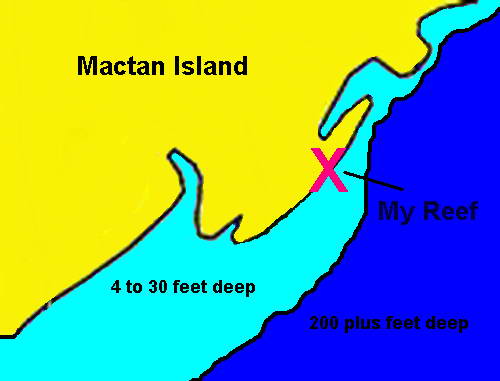

As you can see in the above graphic, a
deep trench forms the channel of the Bohol strait. In the shallow
(light blue) areas, the average depth runs about six feet. It only
drops down to 25 to 30 feet deep within 200 feet of the sheer vertical
channel wall. The farther I go up the coast, the closer the channel
wall will be to shore.
In those areas down the coast, where there is a great deal of
shallow water, it appears that these areas are under assault by a very
fast growing sargassum kelp, which is high lighted below in Zone 3. I
do not see the coral zone having much time left before it is over run
by this "weed". Only by me going up the coast and finding much deeper
water closer to shore do I see the corals as getting any relief from
this pervasive algae.
Another observation that deals with water depth, is that as I go
up the coast and find deeper water close to shore, those coral reefs
found in those locations are near pristine. Only because the water is
too deep for the local people to wade out and do the destruction they
cause by walking on the corals, and by turning over any rock or boulder
that two or three people are capable of flipping over. Once flipped
over, they leave it as such, dooming any life on the rocks, including
the corals of course.

 Zone 1 - Shallow Sea Grass Beds -
One of the most productive communities on earth, These vast
meadows are habitat for large populations of invertebrates and fishes,
providing some of the richest nursery and feeding grounds. I view this
area as being much like a terrestrial field of grass, in that there is
a great deal of organics from the leaf litter decomposing.
Zone 1 - Shallow Sea Grass Beds -
One of the most productive communities on earth, These vast
meadows are habitat for large populations of invertebrates and fishes,
providing some of the richest nursery and feeding grounds. I view this
area as being much like a terrestrial field of grass, in that there is
a great deal of organics from the leaf litter decomposing.
This decomposition and its resultant rich "mud" provides for a
great many animals that act on the "soil" much like earth worms do in
similarly rich soils. While many of the larger, more visible worm
species consume the dropped sea grass leafs in the earliest stages of
decomposition, there are also a great many, much smaller worms within
the "soil" consuming and further breaking down the remnants of the leaf
litter. For more information and photos, please click HERE.
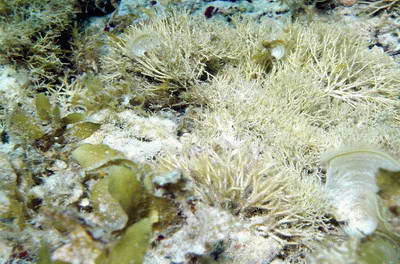 Zone 2 - Macro Algae covered Rock Rubble -
This area is comprised of small calcium carbonate based rocks and
rubble, the average rock size is roughly eight square inches, with much
larger and smaller rocks to be found as well. Some sections will hold
nothing but the average to larger sized rocks with a few inches of sand
bed in between.
Zone 2 - Macro Algae covered Rock Rubble -
This area is comprised of small calcium carbonate based rocks and
rubble, the average rock size is roughly eight square inches, with much
larger and smaller rocks to be found as well. Some sections will hold
nothing but the average to larger sized rocks with a few inches of sand
bed in between.
The sand bed in this area is much more like what we see within
our aquariums, not having any where near the organic load that the
grass beds have. In other areas, it is comprised of small rock rubble,
no more than walnut sized, creating a six inch layer on top of a
shallow sand bed, below the sand bed lies the lava bed rock. The small
rubble areas do not hold much algae, which I attribute to the smaller
rocks being easier to roll about, not giving the algae a chance to gain
a foothold.
All of this makes for a great many hiding and living places for
a multitude of smaller life forms. Which in turn attracts its share of
predators. For more information and photographs, please click HERE.
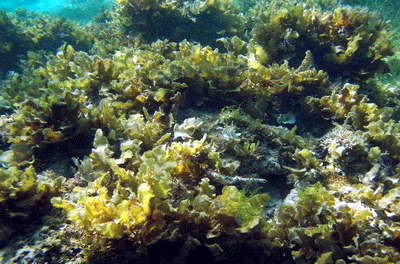 Zone 3 - Sargassum Kelp covered Boulders -
While this area provides its own unique habitat with its shadows
and thick cover, I can not help but to have a bit of a disdain for it.
Simply because I am partial to the corals and have watched this plant
creep ever so slowly into the corals habitat and smother out all other
life where ever it is to be found.
Zone 3 - Sargassum Kelp covered Boulders -
While this area provides its own unique habitat with its shadows
and thick cover, I can not help but to have a bit of a disdain for it.
Simply because I am partial to the corals and have watched this plant
creep ever so slowly into the corals habitat and smother out all other
life where ever it is to be found.
With that said, I also realize that this area provides a needed
function by removing the excess nutrients before they can reach deeper
waters and thus the corals, as well as providing food and shelter for a
good many species of animals and algae. Since 2004 I have watched this
plant ever so slowly take over areas once held by corals. During 2006,
It was
becoming apparent to me, that in just a matter of a few years, all of
the corals would be in danger or lost outright. Very depressing.
I have tried to limit this algae by pulling the plant off of a
few rocks that I knew were once the corals domain. Needless to say,
this plants growth can fast out pace any of my weak attempts at
trimming it. I had all but given up and resigned myself to watching my
pet shallow water corals smothered to death. For more information and
photographs, please click HERE.
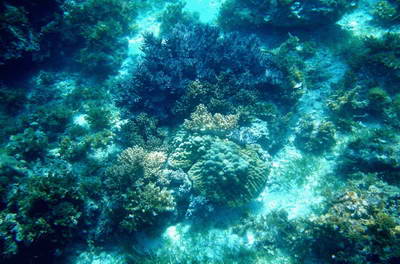 Zone 4 - The Coral Reef -
My pride and joy! Laying face down over a healthy coral reef not
only inspires me to try and emulate what I see within my own aquarium
system, it also fills me with wonder at the just the sheer diversity of
life that can be found living here.
Zone 4 - The Coral Reef -
My pride and joy! Laying face down over a healthy coral reef not
only inspires me to try and emulate what I see within my own aquarium
system, it also fills me with wonder at the just the sheer diversity of
life that can be found living here.
Yes, corals are the most prominent feature and are what comes to
mind when the word "reef" is thought of, but there are just so many
other life forms included within that single word, most all of those
life forms can however, thank the corals for providing a place to live.
The sheer numbers of coral species here is truly staggering,
even after a number of years of visiting the reefs on a weekly basis, I
have come to learn that each dive will reveal a few species that I have
not pesonaly seen in the wild yet. I have tried on a few occasions to
name off the corals as I swam along and quickly lost count, there are
just
too many species to keep track of without having pen and paper handy.
This area gently slopes downwards to a flat shelf that goes on
for another few hundred feet before it drops off as a vertical wall.
Along the slope, it is mostly large boulders and outcroppings that are
covered in corals. Even the space between such formations hold a good
number of species. Between those corals and the rocks, there is a sand
substrate, although it is very shallow, no more than ten inches deep.
Below the sand is the lava based bedrock.
On any given boulder, I have counted on average, at least twenty
species of corals, with some macro algae and sponges mixed in.
Scattered throughout the area, growing on slight rises of the bedrock
(sand free) there are single massive coral colonies that are as large
as a kitchen table. I can only guess at the great many years it took to
grow that large. For more information and photographs, please click HERE.
Regardless of the habitat, they all face threats from quite a
few fronts, all caused by mankind of course. The most problamatic and
most likely, the least thought of, is that what we do on the land has a
great effect on the nearby reefs.
As the island populations grow, and with such a poor economy,
deforestation for both fire wood and the planting of crops allows for a
great amount of silt to enter the ocean, thus choking entire regions of
reef. Add to this, the unregulated and untreated waste waters being
dumped directly into the oceans greatly increases the available
nutrients, allowing algae to dominate all substrates once held by
corals. I see this becoming ever invasive as each year passes.
As if the above was not enough, There are still quite a number
of peaple that rely upon what they can hunt and gather from the near
shore reefs for their daily food needs. While primitive methods are
usualy employed, they are still very effective in doing long term
sustained damage as the people turn over any and all boulders looking
for anything that may be living or hiding under such substrates, most
always, there are corals and a host of other invertebrate species that
once called the top of such substrates, home, only to see sunlight
again when the next person flips the rock, most often, far too late for
any corals on the rocks any chance to survive.
In addition, any and all reef fish, sea urchins, sea cucumbers
and anything else that one can create a recipe for is much sought
after. I have seen small children, spend entire days snorkeling in the
shallows with very small home made spear guns shooting at reef fish no
larger than a few inches long. Being simple pointed spears, quite a few
of the fish, when hit, are able to swim off and die slowly, which I
find from time to time and become saddened at such waste. On occassion,
I even see fish still swimming about with huge chunks of their flesh
missing from poorly aimed spear guns. Of course these fish are also
doomed to a slow death as well.
Being that humans are all about making life easier through the
use of more efficient methods, the locals have also discovered quite
some years ago that by simply mixing some plant fertilizor and some
diesel fuel, they can make very deadly soda bottle bombs, that are then
tossed onto the reef to allow the resulting blast to stun and kill all
nearby fish.
Makes for easy pickings and one can go home early. Of course,
the blast also destroys great swaths of living reef that the much
sought after fish need to live and reproduce. Something I do not think
such so called fishermen think about or much care about obviously.
On the bright side, and I am so glad to be able to say that
there is actually a bright side, there are now a good many local island
communities that designate entire island regions as sanctuarys and
enforce the restrictions themselves that the government is unable to
do. With increasing tourism, and charging just a dollar or two for dive
boats to have the privelage to bring divers into the sanctuary, such
communities are able to earn tens of thousands of dollars each year,
giving the fishermen an alternate source of income other than blowing
up the reefs.
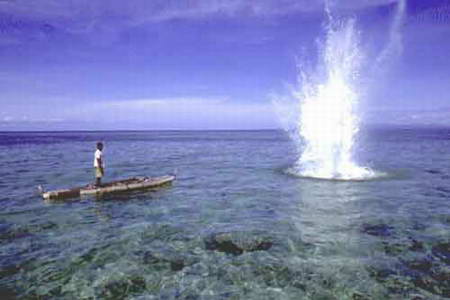
A sound I used to hear far too often while diving, that is, untill local enforcement stopped it.
MoalBoal - Located
on the southern end of the island of Cebu, this area, famous as a
Diving destination held many beautiful sights. A two hour drive from
our home, it was well worth the trip and would recommend it to anyone
considering a diving/snorkeling vacation.
Hilutungan
- Located offshore of Mactan island as one of many very small islands
that surround nearby Olango island. A designated reef sanctuary
where the reef fish have no fear of mankind and will readily take food
offerings right out of your hand. The reef wall is pristine and was a
joy to know that such a reef is still in exsistence. This was my first
dive here in the Philippines that I was acting as the Divemaster for a
group of tourists as well.
There are other habitats of course, such
as the sheer vertical wall that begins at
about 40 feet deep, the numerous caves along the wall, as well as the
deep substrate at the bottom of this sea which is about 250 feet deep.
Areas that I do not have access to, either due to the lack of cave
diving equipment or by it being too deep.
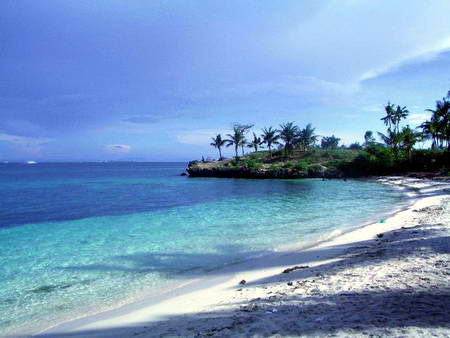
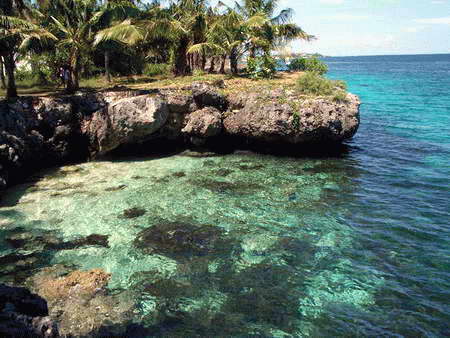
A few scenes from just up the coast
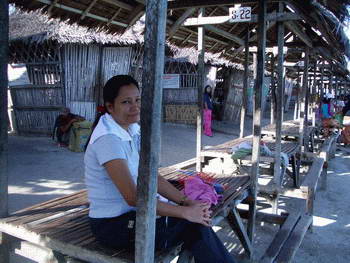
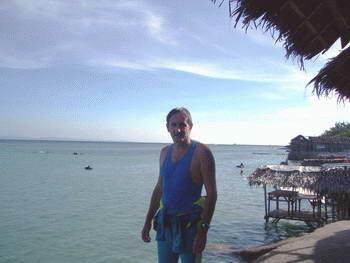
Linda, also known as the safety advisor
Chuck, also known as the chief cause of concern
Acknowledgments: I would be remiss
if I did not give thanks to my wonderful wife Linda, who shares my
child like fascination with the ocean. A special thanks also goes
out to Eric Borneman, Dr. Ron Shimek, Leslie Harris and a host of
others who have shared their wealth of knowledge and their friendship.
Please take a moment and consider supporting any one of the projects listed within. Thank you.

Visitor Count since 24 Jan.08





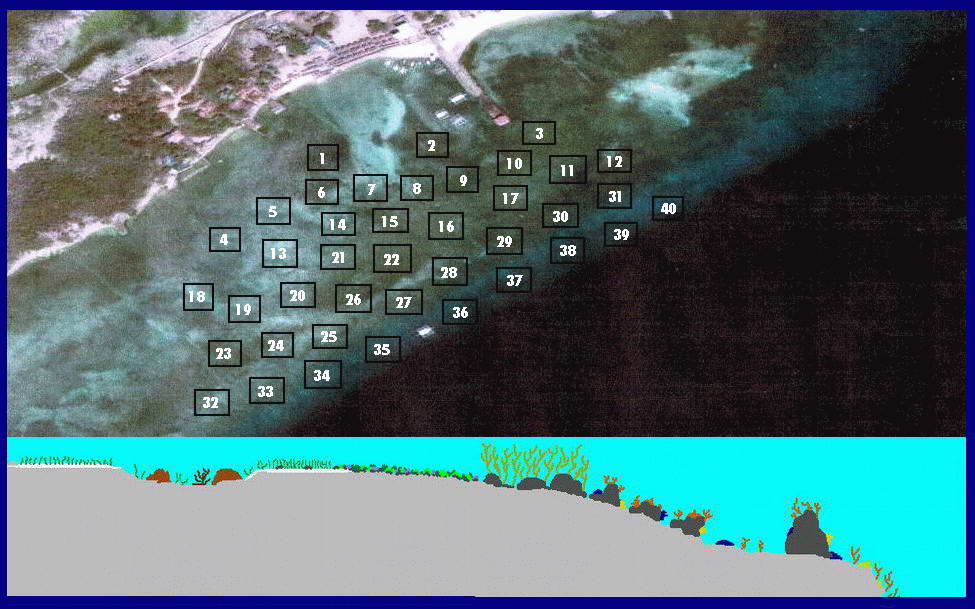





 Zone 1 - Shallow Sea Grass Beds -
One of the most productive communities on earth, These vast
meadows are habitat for large populations of invertebrates and fishes,
providing some of the richest nursery and feeding grounds. I view this
area as being much like a terrestrial field of grass, in that there is
a great deal of organics from the leaf litter decomposing.
Zone 1 - Shallow Sea Grass Beds -
One of the most productive communities on earth, These vast
meadows are habitat for large populations of invertebrates and fishes,
providing some of the richest nursery and feeding grounds. I view this
area as being much like a terrestrial field of grass, in that there is
a great deal of organics from the leaf litter decomposing. Zone 2 - Macro Algae covered Rock Rubble -
This area is comprised of small calcium carbonate based rocks and
rubble, the average rock size is roughly eight square inches, with much
larger and smaller rocks to be found as well. Some sections will hold
nothing but the average to larger sized rocks with a few inches of sand
bed in between.
Zone 2 - Macro Algae covered Rock Rubble -
This area is comprised of small calcium carbonate based rocks and
rubble, the average rock size is roughly eight square inches, with much
larger and smaller rocks to be found as well. Some sections will hold
nothing but the average to larger sized rocks with a few inches of sand
bed in between. Zone 3 - Sargassum Kelp covered Boulders -
While this area provides its own unique habitat with its shadows
and thick cover, I can not help but to have a bit of a disdain for it.
Simply because I am partial to the corals and have watched this plant
creep ever so slowly into the corals habitat and smother out all other
life where ever it is to be found.
Zone 3 - Sargassum Kelp covered Boulders -
While this area provides its own unique habitat with its shadows
and thick cover, I can not help but to have a bit of a disdain for it.
Simply because I am partial to the corals and have watched this plant
creep ever so slowly into the corals habitat and smother out all other
life where ever it is to be found. Zone 4 - The Coral Reef -
My pride and joy! Laying face down over a healthy coral reef not
only inspires me to try and emulate what I see within my own aquarium
system, it also fills me with wonder at the just the sheer diversity of
life that can be found living here.
Zone 4 - The Coral Reef -
My pride and joy! Laying face down over a healthy coral reef not
only inspires me to try and emulate what I see within my own aquarium
system, it also fills me with wonder at the just the sheer diversity of
life that can be found living here.




